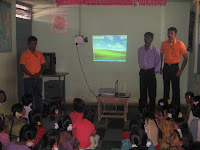Introduction
Entrepreneurial motivation training was an exciting and interested module, which helped to bring out the fellow’s inner feelings and talents and set the goal for the next coming days. A goal is nothing but a set of standards which will be achieved in the future by adding different values through various actions. All the participants learned by this module how to set their future plans.
Entrepreneurial motivation training is very essential to social entrepreneurs because it sparks the mind and stimulates their inner energy. It gives them the platform to express their ideas and thoughts.
Description of the module
Module instructor Rita started with the treasurer hunting game. In this game the fellows should bring and present with innovatively which materials instructor want. It is helpful to improve the fellow’s imagination presentation skills.
Later fellows played goal setting (Ring) game. In this game all the fellows must set their distance level away from goal. Through this game many things were paying attention. In this the instructor can measure the participant’s risk-taking capacity, confidence and influence of environment on mind.
The story writing and scoring activity is the one of the activities of goal setting. The instructor shows six pictures. After seeing the picture the fellows have to write six stories about whatever about comes their mind. Finally fellows filled the entrepreneurial orientation scoring sheet. In this sheet there are 21 questions about internal locus of control and external locus of control.
External characteristics of the person
· More defendants
· Less coordination
· Blaming others
· Passiveness
Internal characteristics of the person
· Achievement oriented person
· Independent in making decision
· Respect others
· Self blaming
Key points of the module
The module started with the practical activity of treasure hunting and its presentation. After that “who am I?” Then by seeing pictures story developing activity was conducted. The purpose of this activity is to assess the thinking process of the participants. Through these activities the instructor explained the process of achievement motivation and the criterion to score achievement imagery. An achievement situation involves the achievement goal with the standard of excellence. The achievement imagery should have the following 11 points.
· A need(N) to achieve on the part of the person.
· Anticipation of success or failure in attaining the.
· Activity (Act) successful or not aimed at attaining the goal.
· Difficulties or blocks (Bp and Bw) to the individuals progress to the goal. There may be personal or external problems.
· Emotional reactions i.e. positive goal anticipation (Ga+) and negative goal anticipation Ga-).
· Help (H) to the striving person from another person.
· Achievement thema, which means the central plot of the whole story, should explain one core goal.
All these factors are called achievement syndrome and and very essential in a story to decide the thinking process of the individual.
All fellows performed a drama by including all the above factors in the story. It gave more clarity about all aspects of achievement syndrome. There was a discussion on “who am I?” This session was really eye-opening for all the fellows.
Major learnings of the module
· Every fellow has treasures in his or her personality.
· Motivation is stimulation to achieve the goal, and it is essential to every individual.
· While setting the goal the individual should consider their abilities, past experiences, their environment.
· Learn from the success or failure.
· During team work we should not create dependency nor I should depend on others in each and every activity.









